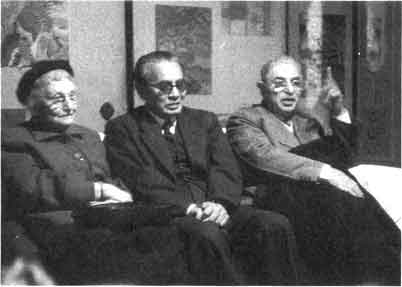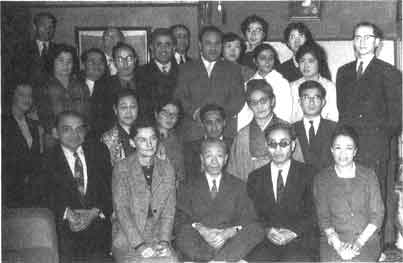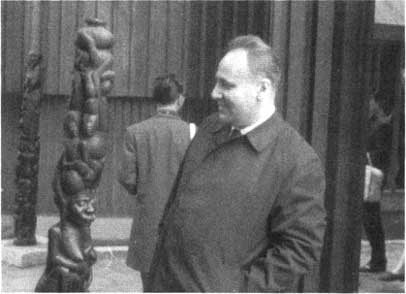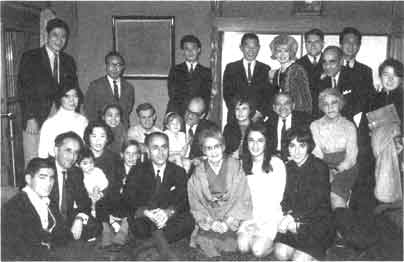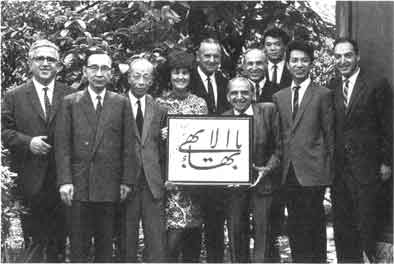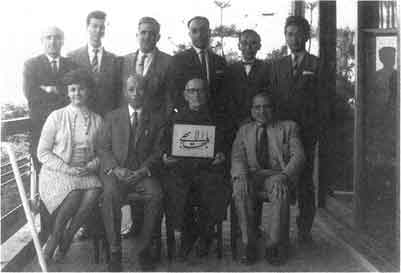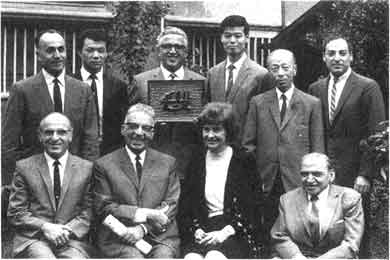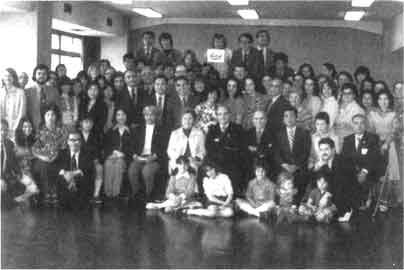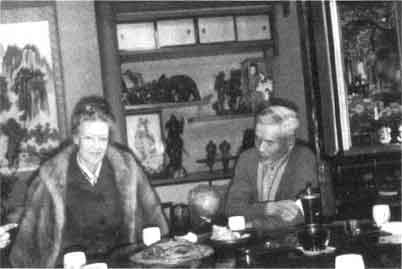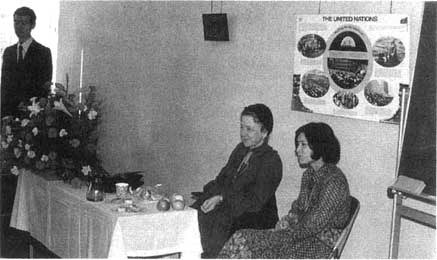
|
Traces That Remain:
A Pictorial History of the Early Days of the Bahá'í Faith among the Japanese
by Barbara R. Sims
edited by Sheridan Sims  |
chapter 81 | start page | single page | chapter 83 |  |
Chapter 82
In 1912 when 'Abdu'l-Bahá was in San Francisco, He was heard to say, "I wish I could go to Hawaii and Japan to see how much capacity the inhabitants of these islands possess for the Cause of God."
He was not able to go to Japan but He encouraged several Bahá'ís to do so to spread the Teachings of Bahá'u'lláh.
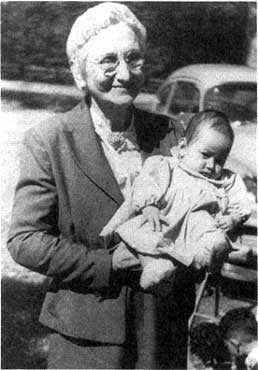
230
Dr. George Augur, who went to Japan at 'Abdu'l-Bahá's bidding in 1914 was designated by the Guardian as one of the Disciples of 'Abdu'l-Bahá. The deep spirituality of Dr. Augur influenced those who came into contact with him. He loved Japan and fit into its culture.

click here for larger image
Miss Alexander with Mr. and Mrs. Seiichiro Tsunemi and their children. Mrs. Tsunemi is Mrs. Torii's sister. Miss Alexander lived with this family for two years in the late 1950s, and was extremely fond of them. Mr. and Mrs. Tsunemi, along with Miss Alexander, were members of the first Local Spiritual Assembly of the Bahá'ís of Kyoto.
'Abdu'l-Bahá in His Will and Testament elucidated the obligations of the Hands of the Cause, however, He did not appoint Hands of the Cause in His Lifetime. The Guardian conferred posthumously the title of Hand of the Cause on some Bahá'ís, and after 1951 he appointed others. This institution, which had been created by Bahá'u'lláh, was expanded by Shoghi Effendi.
Of the seventeen Hands of the Cause (aside from Remey) who visited Japan through the years, two were appointed posthumously by Shoghi Effendi. One was Miss Martha Root, who made four visits. After her death in 1939, Miss Root's station became known. The Guardian, Shoghi Effendi, cabled "Posterity will establish her as foremost Hand which 'Abdu'l-Bahá's will has raised up first Bahá'í century."
Mrs. Keith Ransom-Kehler's high station was made known to the Bahá'í world after her passing in Persia in 1933, two years

Miss Alexander and Sheridan Sims sitting at the back entrance to the old Tokyo Bahá'í Center, 1960.
Miss Agnes Alexander, who spent so many years of her life among the Japanese, was appointed Hand of the Cause in March 1957, just one month before the election of the new regional spiritual assembly, the National Spiritual Assembly of North East Asia. Miss Alexander was elected to this new administrative body and served on it until 1963, when the Hands of the Cause decided to devote all their efforts to their work of propagation and protection and refrain from administrative work.
Miss Alexander was the first Bahá'í in the Pacific area, one of the first to come to Japan, and the first to take the Message of Bahá'u'lláh to Korea. The Guardian called her an "exemplary pioneer."
In 1949, while she was still in the United States, where she had spent the years during World War II, she wrote to a friend, "In all I spent fourteen years there (in Japan) four different times, but not of my own volition, for the Master sent me the first two
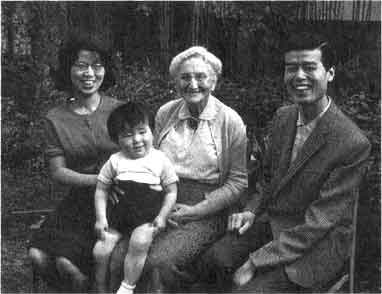
click here for larger image
Miss Alexander with the Hiroshi Yamazaki family at the Tokyo Bahá'í Center, 1965.
In 1949, the Guardian again urged her to return to Japan. She came the next
year, 1950, and left in 1967 in a wheel chair, to spend her remaining years in
her beloved Hawaii, the place of her birth.
|
Arrival in Japan: November 1, 1914 August 9, 1919 January 19, 1928 May 19, 1935 May 1950 |
Departure
from Japan: July 27, 1917 to Honolulu, Hawaii October 12, 1923 to Korea, China, and Honolulu May 30, 1933 to Honolulu, Hawaii March 20, 1937 to Haifa, Europe and the U.S. September 1, 1967 to Honolulu, Hawaii |
It should be said that during her last stay of 17 years, Miss Alexander made many trips of relatively short duration out of Japan, to the United States, to Hawaii, the Holy Land, and countries in Asia, but her base was in Japan, in Kyoto.
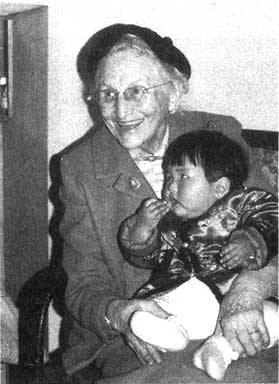
He wrote an account of his extended trip and in the section about Japan (Star of the West, Vol. 19) included three pictures shown here with the original captions.
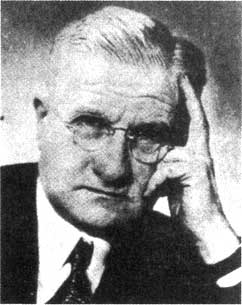
Hand of the Cause Siegfried Schopflocher

click here for larger image
The Bahá'í teacher is Mrs. Kanae Takeshita who was described by Miss Alexander as "a lovely Japanese lady who heard of the Cause from Mrs. Finch." Her students are wearing the Esperanto star.

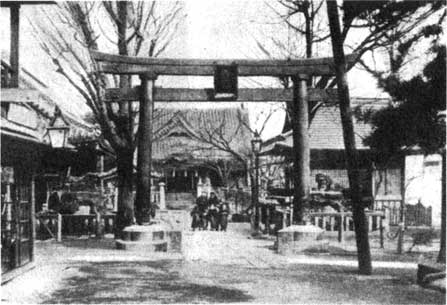
A street scene in Tokyo
236
Mr. Khadem stayed about ten days and met with the Tokyo Local Spiritual Assembly, which had assumed the functions of directing the affairs of the Faith in Japan. The strongest recommendation Mr. Khadem made was to increase the literature of the Faith in Japanese. Immediate efforts were expended and from then on available literature slowly began to increase.
During those ten days, Mr. Khadem tried to meet every Bahá'í in Japan personally. At that time there were about forty-two or forty-three.
The Guardian approved Mr. Khadem's attendance at the Asian Regional Teaching Conference in Nikko, Japan in 1955. He came with his wife this time, and they greatly inspired all Bahá'ís at the conference.
On October 9, after the Nikko conference, Mr. Khadem, accompanied by Miss Alexander and Mr. Noureddin Mumtazi,
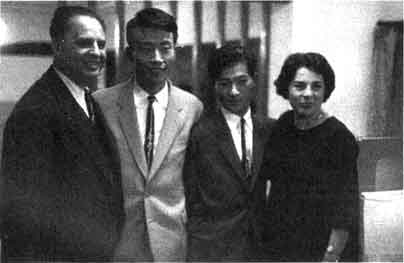
click here for larger image
Mr. and Mrs. Khadem with Mr. Honkawa and Mr. Shoji, the first two to become Bahá'ís in Hiroshima.
The group met several young men at the Hiroshima YMCA where Mr. Khadem spoke. One of the young men, Mr. Michitaka Honkawa, took a pamphlet, read it overnight, and came to the group the next morning saying he wanted become a Bahá'í. Shortly after, one of his friends, Mr. Shoji, also declared himself to be a believer in Bahá'u'lláh.
Mr. Khadem cabled the Guardian the good news of the first believers in Hiroshima. The Guardian cabled back that he was "delighted" and to assure Honkawa and Shoji of his loving prayers. Only three years before, the Guardian had written to the Spiritual Assembly of Tokyo (through his secretary), that "...He was particularly glad to hear teaching will be done in Hiroshima, where the people suffered so mercilessly during the war; they have a special right — the people of that city — to hear of Bahá'u'lláh's Message of peace and brotherhood."
Mr. Khadem returned to Hiroshima a few days after his first visit, this time accompanied by his wife and twenty-three Bahá'ís, mostly Persian pioneers.
About this time Mr. Masazo Odani saw a notice in a Kyoto newspaper of a talk by Mr. Khadem. He attended the lecture and became attracted. He studied the Faith for several months, became a Bahá'í and served faithfully for many years on the Kyoto Local Spiritual Assembly and also on the National Spiritual Assembly of North East Asia.
Teaching continued regularly in Hiroshima, and in 1957, Mr. and Mrs. Assassi and Mr. M. Labib settled there as pioneers. Mr. Labib was soon to move on to open the island of Kyushu to the Faith.
Hand of the Cause Mr. Jalal Khazeh visited Japan twice. The first time was in 1957, when he was the Guardian's representative at the first National Convention of the Bahá'ís of North East Asia. He met with the new national assembly shortly after it was elected, advising and helping it get organized.
The Guardian had given him some small flacons of attar of roses to anoint the friends attending the convention. After using some of the attar of roses, Mr. Khazeh gave the flacons to Bahá'ís in Japan. The compiler still has the one he gave her.
Mr. Khazeh visited Hiroshima in 1957. Miss Noriko Matsuura (Fujii) was a student at Hiroshima University, when she attended Mr. Khazeh's lecture. Now, over thirty years later she can still recall the strong impression it made on her. Soon after, she became a Bahá'í and her life changed.
Mr. Khazeh's second visit in 1973 was memorable. He met with the national spiritual assembly to obtain information and give suggestions. He was concerned about deepening in the concept of God and His Manifestations in a country where Buddhist belief prevails. He had practical suggestions as to how to handle the problems of deepening.
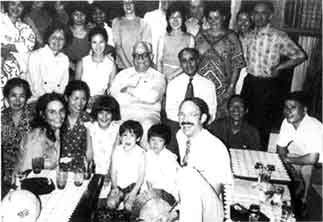
click here for larger image
A meeting with Mr. Khazeh in Ashiya, 1973. At this meeting the Hand of the Cause told the friends moving stories of the transitional period between the passing of the Guardian, 1957, and the election of the Universal House of Justice, 1963, when the affairs of the Faith were managed by the Hands of the Cause.

click here for larger image
Mr. Khazeh visited a Kobe Bahá'í, Miss Yoshiko Kimura (right) who was hospitalized after an operation on her ear. She was thrilled to have a Hand of the Cause visit her hospital room. To the left is a Bahá'í from the Philippines, Ms. Nimfa Dimapilis Connolly.
Mr. Shu'a'u'llah Ala'i was appointed Hand of the Cause in 1952. He visited Japan once, in December 1959. He met with the national spiritual assembly and visited several communities. It is recorded that there was a meeting of thirty in Osaka. He spoke of the fundamental Teachings of Bahá'u'lláh, which would bring about peace.
The Local Spiritual Assembly of Akashi welcomed him at a gathering which thirty people attended.
There was a meeting at the International Hotel in Kobe with over seventy people in attendance. A Kobe newspaper reporter interviewed him.
Mr. Ala'i also spoke at meetings in Hiroshima, Takasago and Ashiya, where the mayor of the city visited him. There were also two meetings in Tokyo. Before his departure for Iran, he met the Persian Bahá'ís stressing the need for unity and teaching.

click here for larger image
Mr. Ala'i (center) meets with the Persian friends in Kansai. At the time there were about twenty-seven adult Persian Bahá'ís in Japan.
Of the many who visited Japan, perhaps the person who had the greatest impact on the development and expansion of the Faith in Japan, aside from dear Miss Alexander, was Hand of the Cause Dr. Ramat'u'llah Muhajir.
Dr. Muhajir was in the final contingent of Hands of the Cause appointed by the Guardian in 1957. He had a great love for Miss Alexander, whom he first met at the Singapore Conference in 1958. His first visit to Japan was in 1961 and he came nineteen or twenty times in all.
Whenever he came, he met with the national spiritual assembly, with one or two exceptions, and he often had a completely different theme from the time before — highly imaginative, but very practical, carefully worked out in his agile, far-seeing, brilliant mind. With him, everything was teaching or some aspect of it, such as proclamation. Our successful and colorful "Expo `70" pamphlet was designed by Dr. Muhajir, but he referred to it as ours, never taking any credit. The pamphlet was also produced in Korean and Chinese.
Through the years, mass conversion was started by Dr. Muhajir personally or under his direction in several countries, resulting in ever-increasing numbers of Bahá'ís.
His sudden and untimely passing in December 1979 left us bewildered. Our dear friend, who had helped guide our footsteps along His Path, was gone.
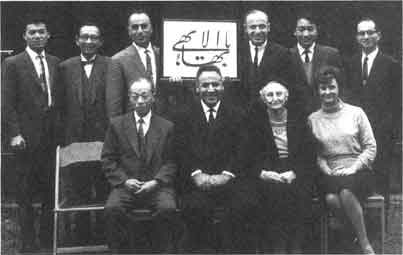
click here for larger image
During his visit in 1964, Dr. Muhajir and Miss Alexander met with the National Spiritual Assembly of the Bahá'ís of North East Asia.Seated are Dr. Mizuno, Dr. Muhajir, Miss Alexander and Mrs. Sims. Standing are Dr. Suzuki (who was not yet a member of the national assembly), Mr. Odani, Mr. Moghbel, Mr. Mumtazi, Dr. Hosoda and Mr. Takano.
National assembly members missing are Dr. Earl, and Mr. Schreiber, who took the photograph.
The first visit of Dr. Muhajir to Japan at the Tokyo Bahá'í Center, March 1961.

244
Dr. Muhajir at the home of the Enomoto family in Iwamizawa, Hokkaido, 1969. Mrs. Orpha Daugherty, second from left, and Mr. and Mrs. Hideya Suzuki, third and fourth from the left, accompanied him.

In a happy moment Dr. Muhajir speaks to the National Convention, Tokyo, 1976.
245

In 1976 Dr. Muhajir visited Mr. Shigeo Hario in his hospital room in Nagasaki, Kyushu. Mr. Hario was the first to become a Bahá'í in Kyushu.
Dr. Muhajir never had time for any kind of sight-seeing during his busy visits to Japan. But he did agree to go with three or four of the Bahá'ís to see the international exposition, Expo `70, in Osaka. The national assembly was distributing half a million of the successful "Expo" pamphlets at the site during the Expo period.
The friends were happy to see Dr. Muhajir enjoying the exposition, but suddenly he disappeared. They looked everywhere for him, then became worried. When he failed to appear after an hour, they began to say prayers for his protection, and looked up to see him strolling by. He was very surprised and said, "Just think! You were saying prayers for me!" He had seen a barber shop, and not one to waste time, had taken the opportunity to have his hair trimmed.In the picture above Dr. Muhajir is admiring an African wood carving at Expo `70.
Mr. A.Q. Faizi was appointed Hand of the Cause in 1957. He made three visits to Japan, the first in 1963. The Bahá'ís of Tokyo gave a big party to welcome him.
Mr. Faizi's second visit was November 1967. He stayed about two weeks. On this occasion Dr. Muhajir had cabled to the national spiritual assembly that Mr. Faizi was coming and suggested arranging press conferences. Two press interviews were arranged for him. The one in Tokyo was also attended by Mr. Bernard Leach, who introduced Mr. Faizi to the reporters.
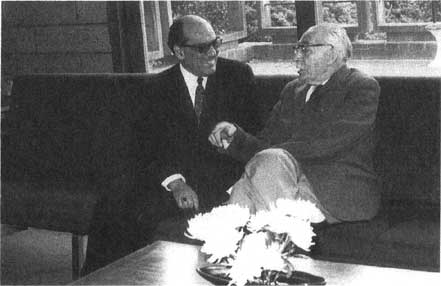
Mr. Faizi chats with Mr. Bernard Leach before a press interview at International House, Tokyo, 1967.
During his second visit, Mr. Faizi went to Sapporo, Hokkaido, where a public meeting had been arranged at the Daiichi Hotel. There was also a meeting at the Hazira just for Bahá'ís. Then he went to Shiraoi, and spoke in the new Hazira there to an audience of sixty people largely of Ainu background. The principal of the high school invited him to speak to the students. Mr. Faizi's visit was reported in several newspapers.
The last visit of Mr. Faizi was in 1970. Most of his time was spent in the Kansai area. The Bahá'ís flocked around him and literally sat at his feet as he gave his unique deepenings.
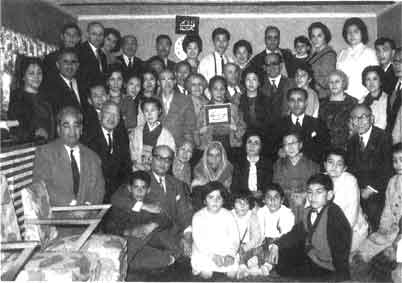
click here for larger image
Mr. Faizi, with dark glasses, standing in the second row from the rear, was speaker at a meeting in Kansai, 1963. All the Persians and many Japanese Bahá'ís attended.
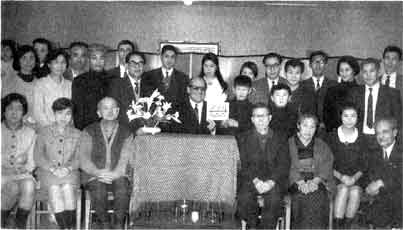
click here for larger image
249
Mr. Featherstone gave many ideas to follow, and helped us make our first proclamation "kits" to give to newspapers and prominent people.
He told us that when he and his wife made their pilgrimage in 1953, the Guardian had spoken about the spiritual axis between Japan and Australia. Mr. Featherstone, being Australian, said he always felt a special connection with the Bahá'ís of Japan.

click here for larger image
The Ninth Annual Convention of the Bahá'ís of North East Asia, 1965. It was the first visit to Japan of Hand of the Cause Mr. Featherstone. It was the last convention Miss Alexander was able to attend. They are sitting in the front, middle, holding a photograph of 'Abdu'l-Bahá.
Mr. Featherstone and Counsellor Mumtazi met with the National Spiritual Assembly of the Bahá'ís of North East Asia in 1968, and then went out to the garden of the Bahá'í Center to have this photograph taken.From the left. Mr. Abbas Katirai, Mr. Masazo Odani, Dr. Ikuo Mizuno, Mrs. Barbara Sims, Mr. Featherstone, Mr. Philip Marangella, Mr. Rouhollah Mumtazi, Dr. Toshio Suzuki, Mr. Hideya Suzuki and Mr. Eugene Schreiber. One member of the national spiritual assembly was not present.
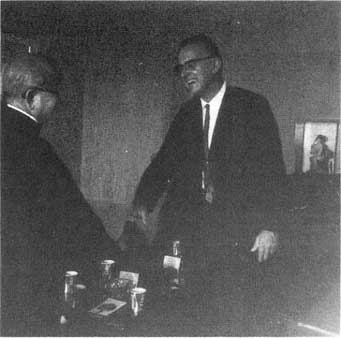
251
He spent time in the Kansai area, went to Hiroshima, and visited Takamatsu on the island of Shikoku. He appeared to be frail, but could call upon a store of spiritual energy that astounded us.
He visited Miss Alexander who was in a Tokyo hospital where she had been for a year with a broken hip. They were joking about which one of them was older. He was by one year, but he told her he would give her the honor!
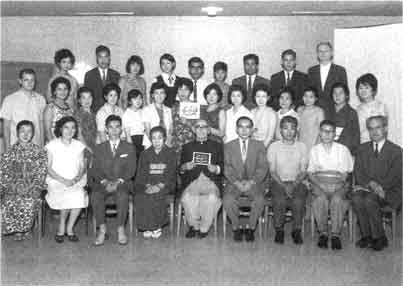
click here for larger image
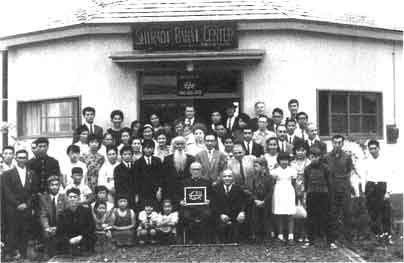
click here for larger image

click here for larger image

click here for larger image
Mr. Samandari spoke at the "Lighthouse" in Kyoto, October 1966. Many Bahá'í meetings had been held on the Kyoto Blind Association premises. Mr. Torii, who is sitting next to Mr. Samandari, was president of the Blind Association.
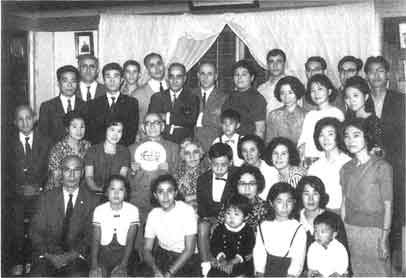
click here for larger image
Mr. Samandari (seen holding the plate) in Hiroshima.

Mr. Samandari visited Mr. Michitoshi Zenimoto in the Hiroshima Municipal Hospital where he was undergoing prolonged medical treatment. Years later Mr. Zenimoto told of this visit, "Mr. Samandari read a healing prayer, and told me that there was no power stronger than prayer. If we trusted in Him, He would answer, and we would know it was true. Now I know that."Mr. Heshmat Vahdat, who accompanied Mr. Samandari that day, is on the left.
Hand of the Cause Mr. Samandari with the National Spiritual Assembly of North East Asia, 1966. Seated are Mrs. Sims, Dr. Mizuno, Mr. Samandari and Mr. Marangella. Standing are Mr. R. Mumtazi, Mr. Yamazaki, Mr. Katirai, Mr. Moghbel, Mr. Odani and Mr. H. Suzuki.
click here for larger image

click here for larger image
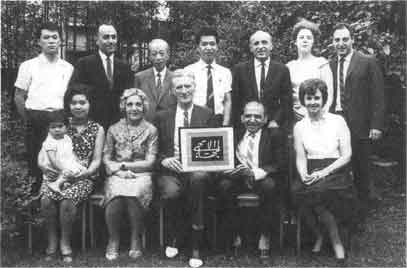
click here for larger image
Hand of the Cause Paul Haney in Tokyo. Seated are Mrs. Chiyo Suzuki holding Rieko, Mrs. Kazempour, Mr. Haney, Mr. Marangella and Mrs. Sims. Standing are Dr. T. Suzuki, Mr. Moghbel, Dr. Mizuno, Mr. H. Suzuki, Mr. Mumtazi, Miss Ruth Walbridge (Suzuki) and Mr. Schreiber.
Mr. Robarts, with the counsellors, met with the National Spiritual Assembly of North East Asia to discuss the goals of the Nine Year Plan. There were meetings in the Tokyo area, including one public meeting. The Bahá'ís rejoiced at his presence at the Summer School.
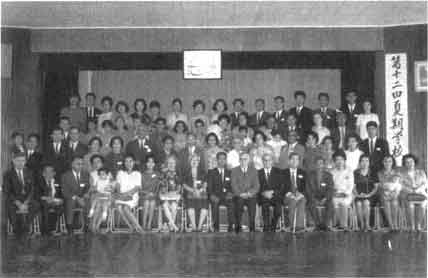
click here for larger image
The Twelfth Summer School, Awaji Island. Hand of the Cause Mr. Robarts is in the middle, sitting. On the left and right of him are newly-appointed counsellors Mr. Samaniego and Mr. Mumtazi.
When he first came to Japan, in 1969, he said he loved the country and would return. He came three more times — in 1971 when he represented the Universal House of Justice at the Oceanic Conference in Sapporo, and again in 1976 and 1977. During those visits he travelled extensively attending press conferences, public meetings, a teaching conference, a deepening conference sponsored by the Continental Board of Counsellors, an autumn school and many smaller meetings. During his visits he met almost all the Bahá'ís in Japan and his depth, wit, and humor surely touched all.
During his visit in 1976, Mr. Furutan, with his son-in-law Dr. Muhajir, met with the National Spiritual Assembly of the Bahá'ís of Japan. The following photographs were taken during his 1969 visit.
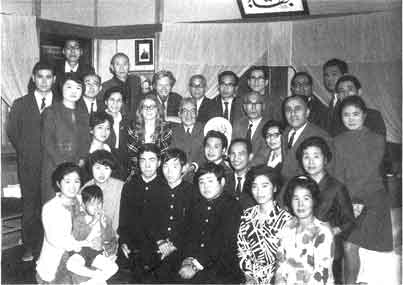
click here for larger image
Mr. Furutan, with a typical big smile, sitting in the middle, at a meeting in the Hiroshima Bahá'í Center.
Mr. Furutan, sitting second from the left, is shown here with eight members of the national spiritual assembly and Counsellor Mumtazi, sitting to the left, in the garden of the old Tokyo Bahá'í Center.
Mr. Enoch Olinga was appointed Hand of the Cause in 1957. Japan had the honor of his visit in December 1970. His first evening was spent at the Tokyo Hazira where a party had been arranged for him to meet all the Bahá'ís in the area.
He also met with the national spiritual assembly while he was in Tokyo. Accompanied by Counsellor Mumtazi, he went to Hokkaido, and was guest of honor in three different communities, Shizunai, Shiraoi and the Urakawa area. He was the only Hand of the Cause to visit the latter area. All the Bahá'ís in the community, twenty-one, and some of their friends, gathered at the local spiritual assembly chairwoman's house to hear him. There was such a spirit of unity that one person declared her belief in Bahá'u'lláh.
In Sapporo there was a good press interview printed in the largest Hokkaido newspaper.
From Hokkaido in the north, Mr. Olinga then went south to Kobe, where he spoke at the university, on Africa and economics, bringing in the Bahá'í viewpoint. He then went to Ashiya, and later Nagoya for meetings.
The effect of the Hand of the Cause coming from far-away Africa was a unique experience for Japanese and pioneers alike.

Hand of the Cause Mr. Enoch Olinga at the Tokyo Bahá'í Center.

Mr. Olinga (with the light over his head), in the predominately Ainu town of Anecha, Hokkaido. The woman sitting on the left has the traditional tattoo around her mouth. That custom is not followed these days.
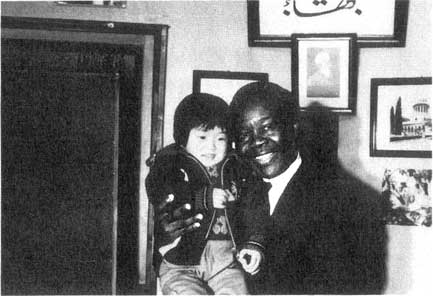
261
It was actually the eighteenth annual convention in Tokyo, but the first for the National Spiritual Assembly of Japan.
We were most eagerly looking forward to Mr. Sears' presence, but we were a little worried that the Japanese friends, or even the translators, would not be able to catch his rapid-fire, highly eloquent style of English. He didn't change his style, but somehow everyone understood him.
He met with the new national spiritual assembly and had other meetings in Tokyo, the Osaka area, Hiroshima and Ube. He visited the homes of several Japanese Bahá'ís: Dr. Suzuki, Mr. Kobayashi (Ube) and Mrs. Noriko Fujii, to mention some.
He and his wife, Marguerite, captivated the Bahá'ís of Japan completely.
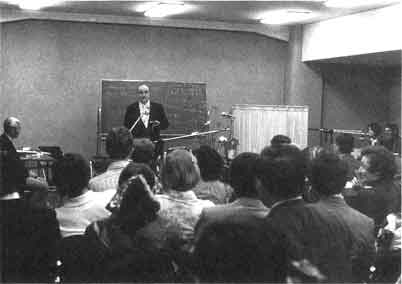
click here for larger image
Hand of the Cause Mr. William Sears addressing the assembled delegates and friends at the first National Convention of the Bahá'ís of Japan, 1974.
Hand of the Cause Mr. William Sears and his wife (center), attend the first National Convention of the Bahá'ís of Japan, 1974.
Amatu'l-Bahá Ruhiyyih Khanum was appointed Hand of the Cause in 1952, after the passing of her father, Hand of the Cause Sutherland Maxwell. She made two visits to Japan. The first was in 1977. She became ill and stayed only one week during which time she was able to attend only two or three activities. However, she said she would return. She did, the following year, with great energy. She stayed nine weeks and visited thirty-six cities and towns on the four major islands of Japan. Many meetings were arranged in various localities so that every Bahá'í in Japan would be within easy traveling distance to see her. She met with numerous mayors, governors and other prominent people and had several press interviews — one of the best was with the Asahi Shimbun which has a circulation of 7.5 million all over Japan.
During her visit, a pioneer conference was held in Ashiya. Every pioneer and spouse was invited to attend. Accommodations were provided by the ever-gracious Mumtazi family. About seventy people came even from remote areas such as Hokkaido
Mrs. Violette Nakhjavani was traveling with Ruhiyyih Khanum and she attended all meetings, including the one with the national spiritual assembly. She also spoke at fireside meetings.
A high point of Ruhiyyih Khanum's trip to Japan was a visit with Prince Mikasa, brother of the Emperor, and his wife Princess Mikasa.
Ruhiyyih Khanum said later that Prince Mikasa was especially interested in her accounts of meeting with Bahá'ís of the minority groups (Ainu and Buraku) in Japan.
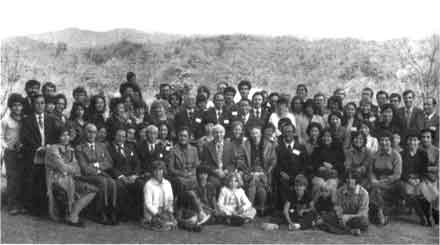
click here for larger image
The National Teaching Conference in Onoda, Japan, 1978. Ninety-five Bahá'ís attended in all. Ruhiyyih Khanum is sitting near the middle, wearing a coat and veil. Counsellor Samaniego is to the right. Counsellor Mumtazi is sitting to the left and Mrs. Nakhjavani is next to him.
Ruhiyyih Khanum meets Dr. Kimiyo Michi, president of Japan Women's University, the oldest university for women in Japan. It was in the founder's notebook that 'Abdu'l-Bahá wrote a prayer for Japan, 1912.From the left are two teachers, then Ruhiyyih Khanum, Dr. Michi, Mrs. Nakhjavani, Miss Iwakura and another teacher.
Ruhiyyih Khanum has tea at the lovely farm home of Mr. Takumi Fujiwara, (shown here), the first Bahá'í of Kaita, Hiroshima Prefecture.
click here for larger image
All the pioneers in Japan were invited to a conference in Ashiya to meet and hear Ruhiyyih Khanum. She is sitting in the middle.
Ruhiyyih Khanum speaks at a United Nations Day meeting in Sagamihara. To the left is the chairman, Mr. Hiroshi Yamazaki. Seated are Ruhiyyih Khanum and Mrs. Kimiko Schwerin, Auxiliary Board Member, who was translating. This photograph was taken in 1977 at one of the few events Ruhiyyih Khanum was able to attend during the week she was in Japan for the first time.

This photograph shows the first Japanese woman to become a Bahá'í , Mrs. Yuriko Furukawa with Ruhiyyih Khanum. They had first met over fifty years earlier, when Mrs. Furukawa, known then as Yuri Mochizuki, went to France to study.
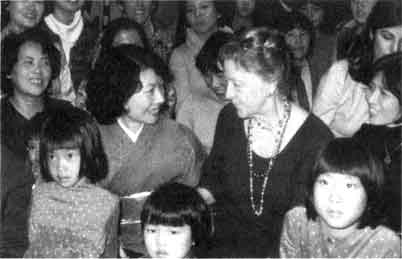
click here for larger image
267
At that time we couldn't have known that the next time some of us would see him, we would meet in the Holy Land and he would be a member of the Universal House of Justice. He was elected to the Universal House of Justice in 1982 in a by-election after the passing of Mr. Amos Gibson.
Mr. Hushmand Fatheazam, member of the Universal House of Justice since its election in 1963, came to Japan in 1977 as a representative of that Divine Institution. Although we were working hard to spread the Faith, it was not going as well as could be expected for such a dynamic country as Japan.
Mr. Fatheazam had many things to say to us. One thing we especially remember was that although the Faith in Japan was established by pioneers, it should grow according to the cultural and indigenous exigencies — that Bahá' i meetings should not
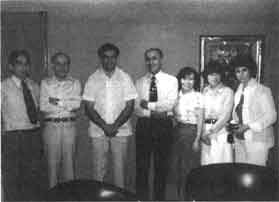
click here for larger image
A meeting in Tokyo 1977 with Universal House of Justice member Mr. Hushmand Fatheazam, third from the left. Counsellor Mumtazi is second from the left. Others are national spiritual assembly members: left, Mr. Yamaguchi. Next to Mr. Fatheazam is Mr. Moghbel, then Miss Iwakura, Miss Fushimi and Mrs. Sims.
 |
chapter 81 | start page | single page | chapter 83 |  |
|
|
